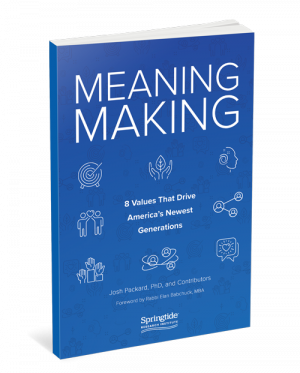
Welcoming: Onboarding and Orientation as Welcoming Practices
Below is an excerpt from Meaning Making: 8 Values That Drive America’s Newest Generations. Follow along on the blog for more excerpts, check out the additional resources on our Meaning Making page, and buy the book here.
A majority of young people we surveyed expect not only to be welcomed—whether it be at a place of worship, a job setting, or some other group or organization—but to be responsible for welcoming others as well. One company that goes out of its way to create a culture of welcome is Warby Parker, particularly in their well-honed practice of onboarding.
Commenting in an article for the online First Round Review, Warby Parker founders Dave Gilboa and Neil Blumenthal explained the importance the eyeglass manufacturer places on onboarding. “You have to make people feel special and welcome from the very first moment they interact with your organization,” says Gilboa. Efforts include a unique welcome packet that includes an office map, a style guide, and a copy of Jack Kerouac’s Dharma Bums, which inspired the company name. Gilboa said the intent is to make the company “heritage part of the employee experience from day one.”
A helium balloon attached to a new employee’s desk signals to others in the company to go out of their way to extend welcome, and other onboarding efforts are driven by company leaders, in part because they possess institutional knowledge and also to drive home the importance of new employees to the company.
Warby Parker’s attention to small but meaningful details—like a helium balloon, a map, and an invitation into the company’s very identity with the gift of a book—combine to make sure the new person experiences welcome. A new employee arrives with the unmistakable sense that their coworkers were expecting, even awaiting, their arrival. But perhaps even more important than these small gestures or orienting materials is that they always happen on day one.
The significance of onboarding and welcoming someone right away cannot be overstated. It seals the first impression and heads off the inevitable worries and concerns that come with being new to a group or organization. “You feel like you have to prove your value right away,” the First Round Review article observes. “Everyone around you has some degree of shared history, inside jokes, and institutional knowledge.” While many of those cultural factors are reasons to join a company, they can also be off-putting to someone who isn’t already well versed in it. This is why a thoughtful process of onboarding—of welcoming—matters so much.
This warm and thoughtful welcome at the start of a new job isn’t just important for the new employee: it’s important for the company. In an article for Quartz at Work, Liz Fosslien and Mollie West Duffy summarize a finding from a 2017 study of language in the workplace, “Alignment at Work,” to offer a compelling case for a welcoming workplace. “Not belonging or feeling a sense of isolation is among the strongest predictors of turnover. A study analyzing emails showed new employees who do not switch from ‘I’ to ‘we’ pronouns during the first six months at their jobs are also more likely to leave.”
In this case, Warby Parker not only welcomes new employees but also gives employees the chance to share that positive experience and welcome others—a high value for young people. The popularity of the brand among young people is a reflection of this attentiveness to the experience of others.
Other organizations can learn from this example: welcoming a new person into a group, team, club, or company should be a thoughtful set of gestures and activities with goals to greet, give direction, and begin initiating that person in the culture, language, and history of the organization. When this warm welcome is offered by many within the organization and happens on the first day, it is even more powerful.
Act on the Data: Imagine creating a “Welcoming Kit” for your organization. What would be included to help a new person understand your history or identity? How would that person’s schedule help them get to know individuals and the whole group? Consider implementing a real welcome strategy, if you don’t already have one, for both new members and those who may be on the periphery of joining—how might you welcome them in different ways?




